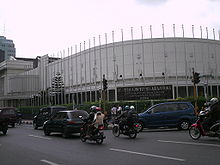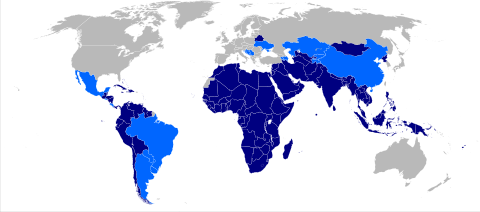- Asian–African Conference
-
The first large-scale Asian–African or Afro–Asian Conference—also known as the Bandung Conference—was a meeting of Asian and African states, most of which were newly independent, which took place on April 18–24, 1955 in Bandung, Indonesia. The twenty nine countries, which participated at the Bandung Conference, represented nearly one fourth of the Earth's land surface and a total population of 1.5 billion people.[1] The conference was organized by Indonesia, Burma, Pakistan, Ceylon (Sri Lanka), and India and was coordinated by Ruslan Abdulgani, secretary general of the Indonesian Ministry of Foreign Affairs.
The conference's stated aims were to promote Afro-Asian economic and cultural cooperation and to oppose colonialism or neocolonialism by either the United States or the Soviet Union in the Cold War, or any other imperialistic nations. The conference was an important step toward the crystallization of the Non-Aligned Movement.
Contents
Background
The conference of Bandung was preceded by the Bogor Conference (1954) and was followed by the Afro-Asian People's Solidarity Conference in Cairo[2] in September (1957) and the Belgrade Conference (1961), which led to the establishment of the Non-Aligned Movement.[3] In later years, conflicts between the nonaligned nations eroded the solidarity expressed at Bandung.
The conference reflected what the organisers regarded as a reluctance by the Western powers to consult with them on decisions affecting Asia in a setting of Cold War tensions; their concern over tension between the People's Republic of China and the United States; their desire to lay firmer foundations for China's peace relations with themselves and the West; their opposition to colonialism, especially French influence in North Africa and its colonial rule in Algeria; and Indonesia's desire to promote its case in the dispute with the Netherlands over western New Guinea (Irian Barat).
Soekarno, the first president of the Republic of Indonesia, portrayed himself as the leader of this group of states, naming it NEFOS (Newly Emerging Forces).[4]
Discussion
Major debate centered around the question of whether Soviet policies in Eastern Europe and Central Asia should be censured along with Western colonialism. A consensus was reached in which "colonialism in all of its manifestations" was condemned, implicitly censuring the Soviet Union, as well as the West.[5] China played an important role in the conference and strengthened its relations with other Asian nations. Having survived an assassination attempt on the way to the conference, the Chinese premier, Zhou Enlai, displayed a moderate and conciliatory attitude that tended to quiet fears of some anticommunist delegates concerning China's intentions.
Later in the conference, Zhou Enlai signed on to the article in the concluding declaration stating that overseas Chinese owed primary loyalty to their home nation, rather than to China – a highly sensitive issue for both his Indonesian hosts and for several other participating countries. Zhou also signed an agreement on dual nationality with Indonesian foreign minister Sunario.
Outcome
A 10-point "declaration on promotion of world peace and cooperation," incorporating the principles of the United Nations Charter was adopted unanimously:
- Respect for fundamental human rights and for the purposes and principles of the charter of the United Nations
- Respect for the sovereignty and territorial integrity of all nations
- Recognition of the equality of all races and of the equality of all nations large and small
- Abstention from intervention or interference in the internal affairs of another country
- Respect for the right of each nation to defend itself, singly or collectively, in conformity with the charter of the United Nations
- (a) Abstention from the use of arrangements of collective defence to serve any particular interests of the big powers
(b) Abstention by any country from exerting pressures on other countries - Refraining from acts or threats of aggression or the use of force against the territorial integrity or political independence of any country
- Settlement of all international disputes by peaceful means, such as negotiation, conciliation, arbitration or judicial settlement as well as other peaceful means of the parties own choice, in conformity with the charter of the United Nations
- Promotion of mutual interests and cooperation
- Respect for justice and international obligations.[6]
The final Communique of the Conference underscored the need for developing countries to loosen their economic dependence on the leading industrialized nations by providing technical assistance to one another through the exchange of experts and technical assistance for developmental projects, as well as the exchange of technological know-how and the establishment of regional training and research institutes.
Controversy
The United States of America, through its Secretary of State, John Foster Dulles, shunned the conference and was not officially represented. However, Representative Adam Clayton Powell, Jr. (D-N.Y.) attended the conference and spoke at some length in favor of American foreign policy there which assisted the United States's standing with the Non-Aligned. When Powell returned to the United States to report on the conference, the House of Representatives honored him for his contributions.[citation needed]
Legacy
To mark the fiftieth anniversary of the Conference, Heads of State and Government of Asian-African countries attended a new Asian-African Summit from 20–24 April 2005 in Bandung and Jakarta. Some sessions of the new conference took place in Gedung Merdeka (Independence Building), the venue of the original conference. The conference concluded by establishing the New Asian-African Strategic Partnership (NAASP).[citation needed]
The 2005 Asian African Summit yielded, inter-alia, the Declaration on the New Asian African Strategic Partnership (NAASP), the Joint Ministerial Statement on the New Asian African Strategic Partnership Plan of Action, and the Joint Asian African Leaders’ Statement on Tsunami, Earthquake and other Natural Disaster. The aforementioned declaration of NAASP is a manifestation of intra-regional bridge-building forming a new strategic partnership commitment between Asia and Africa, standing on three pillars, i.e. political solidarity, economic cooperation, and socio-cultural relations, within which governments, regional/sub-regional organizations, as well as peoples of Asian and African nations interact.
The 2005 Asian African Summit was attended by 106 countries, comprising 54 Asian countries and 52 African countries . The Summit concluded a follow-up mechanism for institutionalization process in the form of Summit concurrent with Business Summit every four years, Ministerial Meeting every two years, and Sectoral Ministerial as well as Technical Meeting if deemed necessary.
A fascinating literary account, which brings out some overlap between the internationalist aims of African-American politics in the period with Third-world movements can be found in Richard Wright's The Color Curtain: A Report on the Bandung Conference.
Participants
 Countries represented in the Asia-Africa Conference in Bandung, Indonesia in 1955. Twenty-nine independent countries were present, representing over half the world's population. Vietnam is represented twice by both North and South Vietnam.
Countries represented in the Asia-Africa Conference in Bandung, Indonesia in 1955. Twenty-nine independent countries were present, representing over half the world's population. Vietnam is represented twice by both North and South Vietnam.
- Afghanistan
- Burma
- Cambodia
- Ceylon
- People's Republic of China
- Cyprus 1
- Egypt
- Ethiopia
- India
- Indonesia
- Iran
- Iraq
- Japan
- Jordan
- Laos
- Lebanon
- Liberia
- Libya
- Nepal
- Pakistan
- Philippines
- Saudi Arabia
- Syria
- Sudan
- Thailand
- Turkey
- Democratic Republic of Vietnam
- State of Vietnam (Republic of Vietnam)
- Mutawakkilite Kingdom of Yemen
1 A pre-independent colonial Cyprus was represented by [the] eventual first president, Makarios III.[7]See also
References
- ^ Bandung Conference of 1955 and the resurgence of Asia and Africa, Daily News, Sri Lanka
- ^ Mancall, Mark. 1984. China at the Center. p. 427
- ^ Nazli Choucri, "The Nonalignment of Afro-Asian States: Policy, Perception, and Behaviour", Canadian Journal of Political Science / Revue canadienne de science politique, Vol. 2, No. 1.(Mar., 1969), pp. 1-17.
- ^ Cowie, H.R. (1993). Australia and Asia. A changing Relationship, 18.
- ^ Bandung Conference, at Encyclopedia Britannica
- ^ Jayaprakash, N D (June 5, 2005). "India and the Bandung Conference of 1955 – II". People's Democracy - Weekly Organ of the Communist Party of India (Marxist) XXIX (23). http://pd.cpim.org/2005/0605/06052005_bandung%20conf.htm. Retrieved 2007-02-07.
- ^ Cyprus and the Non–Aligned Movement, Ministry of Foreign Affairs, (April, 2008)
Further reading
- Asia-Africa Speaks From Bandung. Jakarta: Ministry of Foreign Affairs, Republic of Indonesia, 1955.
- Kahin, George McTurnan. The Asian-African Conference: Bandung, Indonesia, April 1955. Ithaca: Cornell University Press, 1956.
- Mackie, Jamie. Bandung 1955: Non-alignment and Afro-Asian Solidarity. Singapore: Editions Didier Millet, 2005. ISBN 981-4155-49-7
- Ampiah, Kweku. The Political and Moral Imperatives of the Bandung Conference of 1955 : the Reactions of the US, UK and Japan. Folkestone, UK : Global Oriental, 2007. ISBN 190-5246-40-4
- Finnane, Antonia, and Derek McDougall, eds, Bandung 1955: Little Histories. Melbourne: Monash Asia Institute, 2010. ISBN 9781876924737
External links
- Modern History Sourcebook: Prime Minister Nehru: Speech to Asian-African Conference Political Committee, 1955
- Modern History Sourcebook: President Sukarno of Indonesia: Speech at the Opening of the Asian-African Conference, 18 April 1955
- "Asian-African Conference: Communiqué; Excerpts". Egyptian presidency website. 24 April 1955. Archived from the original on 23 April 2011. http://www.webcitation.org/5y9oJwFjk. Retrieved 23 April 2011.
Categories:- Cold War
- Liberal Democracy Era in Indonesia (1950-1957)
- Sukarno
- Bandung
- 1955 in Indonesia
- 1955 conferences
- Diplomatic conferences in Indonesia
- 20th-century diplomatic conferences
- 1955 in international relations
Wikimedia Foundation. 2010.



